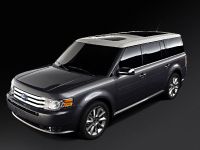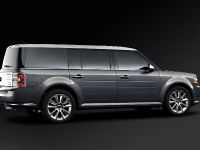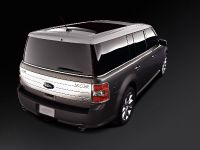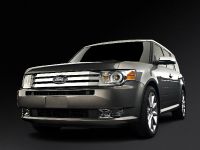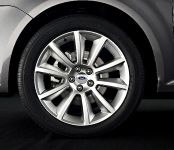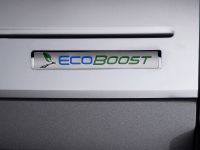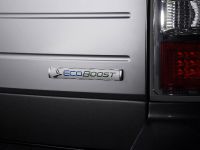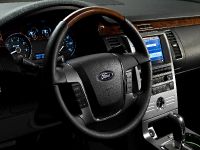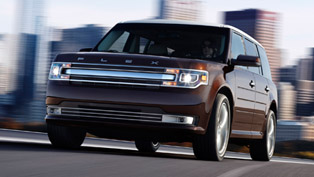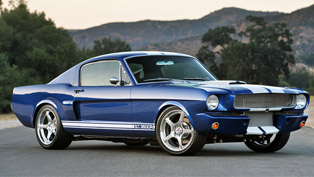Introduction Of 3.5-Liter Ecoboost V-6 Engine Adds Even More Versatility To Distinctive Ford Flex
Ford Flex turns heads with its distinctive design – and in 2009, the unique full-size crossover becomes even more noteworthy, thanks to an available twin-turbocharged 3.5-liter EcoBoost V-6 engine.
This all-new engine gives Flex V-8 power and performance feel with the fuel economy of a V-6.
The twin-turbocharged 3.5-liter EcoBoost V-6 produces an estimated 355 horsepower at 5,700 rpm and 350 foot-pounds of torque at 3,500 rpm. In addition to the power upgrade, the 2010 EcoBoost Flex boasts segment-leading fuel economy among full-size performance crossover vehicles with 22 mpg highway and 18 mpg combined.
The 2010 Flex has unsurpassed fuel economy in the full-size crossover segment with 24 mpg highway and 19 mpg combined, one of a number of new Ford products delivering the best or among the best fuel economy.
"We are committed to delivering fuel economy leadership in every new vehicle," said Derrick Kuzak, Ford's group president of Global Product Development. "We do this with affordable technology that can be applied to the widest number of vehicles. EcoBoost is an important component of that goal.
"The beauty of EcoBoost is that it enables us to downsize for fuel efficiency, yet boost for power. We're able to decrease the size of the available engine – such as installing a V-6 versus a V-8 – yet boost the power using turbocharging to deliver similar power and torque of that larger engine."
The twin-turbocharged 3.5-liter EcoBoost V-6 engine requires all-wheel drive and will be available on well-equipped SEL and Limited models of the 2010 Flex, packaged with several high-demand customer features.
"People who drive the Flex want to make a statement, and the new twin-turbocharged 3.5-liter EcoBoost V-6 is very much in keeping with that attitude," said Ron Heiser, chief engineer of the Ford Flex. "We're proud and excited to add Ford's most advanced engine, which is the first V-6 direct-injection twin turbocharged engine produced in North America, to the Flex line."
The addition of the EcoBoost engine builds on what already is a strong package for Flex.
"We know that there are customers who are looking for the power and performance of a traditional V-8 but are not willing to sacrifice this for fuel economy," said Kate Pearce, Flex marketing manager. "No one else in this segment offers this level of performance and versatility, and when you wrap it up in Flex's unique package, we believe that it will offer a compelling buy in the crossover segment."
The EcoBoost program is part of Ford's ongoing and wide-ranging initiative to deliver fuel-efficient powertrain systems with power and performance found in larger-displacement engines.
"EcoBoost engines offer more power and better fuel economy," said Brett Hinds, EcoBoost design manager. "It's all part of Ford's strategy to bring adaptable powertrain technology to all kinds of vehicles and all kinds of lifestyles. This technology is affordable and applicable to all gasoline engines."
Hinds said the 3.5-liter EcoBoost V-6 will handle any tasks Ford Flex drivers ask of it. "The drivability of EcoBoost engines is superior and it just generates a lot more confidence in your Flex – it goes where you want it to go," he said. "You're rewarding yourself as a driver."
The twin-turbocharged 3.5-liter EcoBoost V-6 also will arrive in the Lincoln MKS and MKT in 2009. Although these are three very different vehicles that serve different needs for customers, the EcoBoost engine can handle the roles seamlessly and effectively. The 2010 EcoBoost V-6 MKT, for example, provides segment-leading fuel economy, exceeding the V-8-powered Audi Q7 by 4 mpg on the highway.
"A key element in our EcoBoost strategy is the efficiency we gain by employing a common control unit across a wide variety of vehicle applications," said Craig Stephens, EcoBoost powertrain control system manager. "All the driver should notice is the seamless power delivery and terrific fuel economy."
The key to the EcoBoost system is the harmony between the twin turbochargers and the direct injection fuel system. The turbochargers recover energy from the exhaust that otherwise would've been wasted and put it back in the engine to gain efficiency. Simply, the turbocharging system puts more air into the engine for more power. A compressor increases or "boosts" the pressure of the air entering the engine. An intercooler reduces the air temperature before it enters the engine.
The twin parallel turbochargers, which are water cooled and operate simultaneously, combine with a direct-injection fuel system to produce power when the driver pushes down on the gas pedal. The high-pressure fuel pump operates up to 2,175 psi – more than 35 times the norm seen in a conventional V-6 engine. The high-pressure pump is a cam-driven mechanical pump with a single piston and an electronic valve that controls how much fuel is routed into the fuel rails to the injectors.
As demands on the twin-turbocharged 3.5-liter EcoBoost V-6 engine are increased, the control system responds to maintain optimal combustion, timing and injection duration.
On each stroke, six individual jets spray fuel directly into the combustion chamber, mixing with the incoming air. "By bringing the fuel injector right into the combustion chamber, there's no delay from the time you inject the fuel to when it's used by the engine," Hinds said.
The fuel injectors are located on the side of the combustion chamber. When the fuel is injected into the cylinder, it evaporates and cools the air that's been inducted into the cylinder. "Another benefit of our direct injection method is that it cools the air right where you're going to burn it," Hinds said. "This action both improves the breathing of the engine and minimizes knocking."
The direct injection of fuel into the cylinder also helps provide a well-mixed air-fuel charge, increasing engine efficiency. Direct injection provides several benefits in terms of fuel burn and lower emissions.
"Because the fuel is directly introduced into the combustion chamber, you don't get fuel wetting the combustion wall like with port fuel injection, you don't saturate the ports and you don't get droplets that might recombine and add to saturation," Hinds said. "By injecting fuel directly into the combustion chamber and under high pressure, the fuel can be directed to exactly where we want it to be for a given combustion cycle."
The spray pattern for the fuel was optimized after extensive modeling work, with the angle of how the fuel is sprayed key to the process.
"The better combustion process is a big advantage of direct injection," Hinds said. "In a port fuel system, at key off it's possible to have fuel on the walls of the intake port, which migrates to the top of the valve and puddles. So when you key on, you get that emissions spike. Direct injection is much cleaner from that standpoint."
Turbo lag virtually eliminated
The simultaneous turbocharger operation paired with the direct-injection system help to virtually eliminate turbo lag, one of the main reasons turbocharger technology was not previously more widely used.
The dual-turbocharger setup has several advantages over previous turbocharging systems, including:
- The turbochargers are smaller, resulting in more-compact exhaust manifolds, which don't generate as much heat
- Turbochargers are packaged adjacent to the cylinder block and have improved mounting providing NVH (noise, vibration, harshness) improvements
- The dual turbochargers spool up quicker, allowing the 3.5-liter EcoBoost V-6 engine to reach peak torque faster. The turbochargers spin at approximately 170,000 rpm. By comparison, the redline for the engine is approximately 6,500 rpm
"Our two turbochargers both operate identically over the speed range of the engine – one is responsible for the left bank of the engine and the other is responsible for the right bank," Hinds said. "Both spin immediately and produce boost, even at low engine speeds."
The turbochargers are designed for a life cycle of 150,000 miles or 10 years.
"Our testing is far, far more harsh than could be achieved in the real world," Hinds said. "In an extreme situation, a customer might be able to hit peak power for about 10 seconds – probably not even that much. We test at peak power for hundreds of hours to ensure we can reach our durability and reliability goals."
The turbochargers are only about the size of an orange, but help provide a big performance advantage to customers. Hinds describes the torque response in terms of linear acceleration – power whenever you need it.
"You get peak torque across a very wide engine speed range," he said. "It's available when you pull away from a stoplight or pass someone on a secondary road at a comparatively low speed. You don't need to wind up the engine to get performance out of it. It's there all the time."
Turbocharger "whoosh" is mitigated by electronically controlled anti-surge valves, which proactively relieve the boost in the intake, which can range up to 12 PSI. Precise software calibrations manage the pressures in the intake manifold.
"We control the boost to make sure that customers don't recognize when the boost is building," Hinds said. "As the turbochargers spool up, the electronic control system takes over. Our active wastegate control along with the throttle controls the boost and torque levels very precisely and the customer perceives a continuous delivery of torque."
Extensive durability tests on the twin-turbocharged 3.5-liter EcoBoost V-6 engine ensure it will excel in all conditions. Start-up tests, with a wide variety of fuels, were made in conditions ranging from minus 40 to 110 degrees Fahrenheit. Altitude testing up to 12,000 feet in Colorado also was performed.
"The direct-injection fuel system allows us some real opportunities in terms of optimizing cold start for both emissions and robustness," Hinds said. "We have multiple injections for each combustion event, and we can essentially tune where those injections should take place to deliver the strongest start possible with the lowest emissions."
Mated to the 3.5-liter EcoBoost V-6 engine is the 6-speed 6F-55 SelectShift automatic transmission, which is dedicated to the twin-turbocharger engine.
The 6F-55 transmission was developed from the successful 6F-50 transmission to specifically respond to the increased torque demands of the EcoBoost V-6 engine. Upgrades were made to the transmission's friction material in response to the higher shift energies, and a new torque converter has been optimized for performance and fuel economy.
Additionally, the 6F-55 transmission operates more efficiently. The transmission team was able to reduce the fluid level in the transmission, which in turn reduced weight and drag torque on the system. Upgrades to the transmission's thermal valve mean the system warms up quicker, reducing gear-spin losses.
"We've upgraded the gear sets to handle the increased torque," said Joe Baum, powertrain team leader. "We've also adjusted the final drive ratio and matched the gear ratios to provide the optimum performance and fuel economy.
"Our final drive ratio is 2.73. With a lower final drive ratio, the engine spins lower at highway speeds, which helps save fuel. And with all the torque, the Ford Flex still delivers good low-speed launch performance."
One harmonious system
Careful powertrain system management ensures the engine, turbochargers and transmission work together harmoniously.
"The Flex is a hit with our customers, bringing new customers to Ford," Heiser said. "Adding the 3.5-liter EcoBoost V-6 is just more great news."
